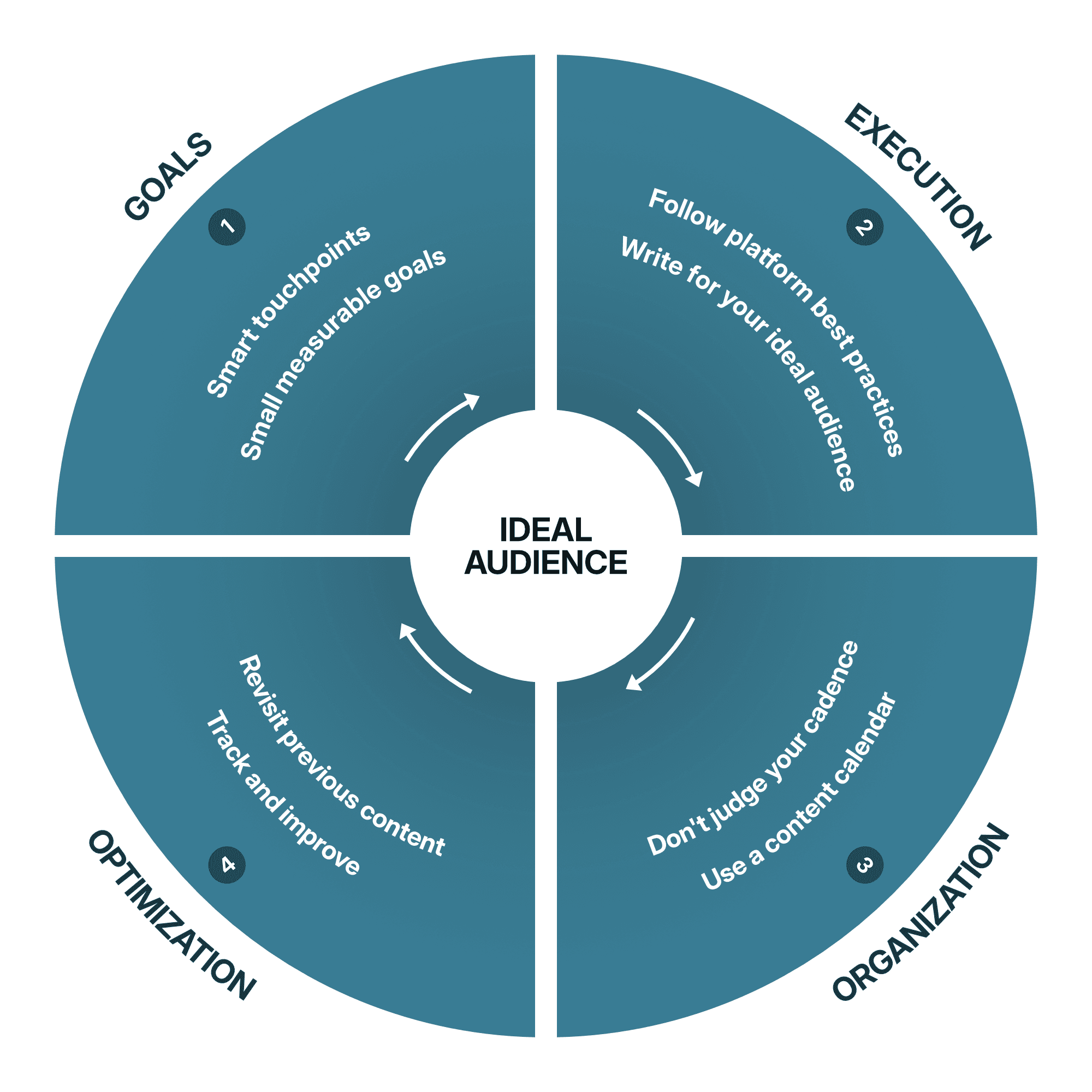Content marketing is constantly evolving, but 2024 has seen one of the strongest shifts towards genuine connection and usefulness in content in…well…maybe forever. The digital landscape is unbelievably crowded, and audiences are craving content that feels authentic and provides value. You can’t simply produce stacks of generic content, sit back, and watch the traffic flow in. That’s not reality. Providing value where you audience is looking for it is what 2024 content marketing is all about.
So, with that new landscape set, let’s look at the top 12 content marketing best practices that will help you save time and resources to connect, engage, and drive real results in 2024.
Understand What Your Ideal Audience is Looking For
To create content that hits home, you need to know exactly who you’re talking to. It’s not just about demographics like age, gender, or location—it’s about diving deep into what your audience cares about, what they’re struggling with each day, and what keeps them up at night. Get to the heart of their needs. Use surveys to ask direct questions, scan social media to see what they’re talking about, and watch your web analytics to understand their behavior. This kind of deep psychographic understanding is what will take your content from generic noise into a valuable resource they can’t ignore.
Content Marketing Best Practices Pro Tip: Use tools like Google Analytics, behavioral analytics, and social media insights to segment your audience into specific groups. This allows you to tailor content precisely to each segment’s unique needs.
Define A Clear Content Focus
Less has never been more in content marketing. Rather than trying to cover every possible topic, take what you learned about your ideal audience in the first point and choose a select few key areas that align with your brand and business goals to focus on. This not only helps in creating deeper, more comprehensive content, but also positions your brand as an authority in those areas. It’s better to be a master of a few high value topics than to scratch the surface of many.
Content Marketing Best Practices Pro Tip: Develop content pillars that reflect your brand’s core expertise and audience interests. Use these pillars to guide your content plans, and don’t stray from them without a good (data driven) reason.
Choose Your Mediums and Channels Wisely
Your audience isn’t everywhere, and you shouldn’t be either. Trying to be present on every platform will spread your efforts too thin, compromise the quality of your content, and almost certainly overwhelm you. Instead, focus on the platforms and content types where your audience is most active and engaged. The key touchpoints where they’re most likely to be looking for the content you’re producing.
Make sure that’s aligned with your team’s strengths, too. Asking a highly skilled but introverted editorial writer to create daily Instagram Reels probably isn’t going to end well.
Double down on the channels and mediums that fit, and be bold about ignoring or phasing out the ones that don’t.
Content Marketing Best Practices Pro Tip: Start with one or two key platforms where your audience is most active. Master these before expanding to other channels to ensure consistent quality and engagement.
Set Some Goals
Be honest - does the idea of being asked to create a ‘Content Strategy’ make you sweat? High level strategic planning is important, but it’s also an overwhelming place to start. Instead, set small, achievable goals. They’ll help you get some runs on the board early, start measuring progress, and give you a feel for what a broader, deeper strategy might shape up to look like.
Avoid vague objectives like “increase engagement” or “get more traffic”. Aim for things that are specific and measurable, like “boost social media shares by 20% in two months”, or “increase visits to x post by 15% next month”.
Don’t try to boil the ocean—focus on what’s doable and impactful, connecting smaller wins together.
Don’t Forget SEO Best Practices, But Write For The Reader
SEO is crucial, but your readers should always come first. Your main focus should be on creating valuable, engaging content that answers what your ideal audience is looking for. Search engines are now smart enough to prioritize content that provides a great user experience, and are actively penalizing content that doesn’t deliver on the helpfulness it promises.
Write content that genuinely helps and engages your readers, and it will naturally perform better in search results.
Content Marketing Best Practices Pro Tip: Blend keywords into your content naturally. Write conversationally, answering your audience’s questions with in-depth, valuable information. This will ensure your content is both SEO-friendly and reader-focused.
Content Marketing Best Practices Pro Tip: Use the SMART (Specific, Measurable, Achievable, Relevant, Time-bound) framework to set your goals. This ensures they’re clear, actionable, and trackable, keeping you focused and on track.
Email Newsletters Are the New Black
In an age where flashy new platforms constantly vie for our attention, email newsletters have made a huge comeback. Unlike social media, where algorithms magically (read: infuriatingly) decide who does and doesn’t see the content we share, emails go direct to an inbox. And it’s what a lot of people are craving - properly useful content that adds something to their life, that’s not surrounded by a million other pieces of content shouting at them, regularly landing in a place they know they’ll see it.
What’s not to like?
Content Marketing Best Practices Pro Tip: Get personal. Use segmentation to tailor your email content to different audience groups, making each message feel relevant.
Use a Content Calendar to Stay Organized
A content calendar for when and where to publish content to an audience will help you stay organized and consistent, but don’t overcomplicate it. A cluttered calendar can be more stressful than helpful. You might decide you need a more extensive planning and scheduling tool at some stage, but they’re often just overwhelming.
Find a tool that strips away all the complexity. It’ll help you build the muscle of a regular content cadence that stays consistent, and give you an easy historical reference of what has gone out, where, and when.
Content Marketing Best Practices Pro Tip: Use a tool like the Content Compass - a powerful, inexpensive Notion template that helps you plan and organize your content (and includes a clean, easy-to-use calendar)
Don’t Stress Over Publishing Cadences
We’ve just talked about ‘consistency’, but don’t let the pressure of a strict publishing schedule burn you out. It’s better to publish high-quality content less frequently than to churn out subpar content just to meet a schedule. Find a rhythm that works for you and your team, and don’t be afraid to adjust it as needed to maintain quality (and your sanity).
Content Marketing Best Practices Pro Tip: Set a realistic schedule that balances consistency with the capacity of your team, and don’t stress if you can’t always stick to it.
Don’t get stuck on the new-Content hamster wheel
One of the smartest ways to get more mileage out of your effort is through repurposing. Instead of constantly creating new content, adapt what you already have for different formats and platforms. Turn a high value blog post into a video, a podcast episode, an infographic, and a series of social media posts. This approach not only extends the reach of your content but also ensures it resonates with different segments of your audience.
Oh, and that post you spent a week crafting, pushed to your website, and then shared once? Hardly anyone would have seen it (thanks, algorithms). Put a slightly different twist on it, and share it again. And then again. And then again.
Content Marketing Best Practices Pro Tip: Create a repurposing plan for each piece of content. Identify multiple ways to adapt and distribute it across various channels, making everything you create go further.
Don’t Neglect Your Existing Content
Your older content can be a goldmine. Regularly auditing your content library can uncover pieces that just need a little love to shine again. Use your analytics tools to spot high-performing posts that have lost some traction. These are your prime candidates for a refresh.
Next, review these pieces for relevance. Is the information still current? Are there new stats or trends you can incorporate? Update the content with fresh insights and re-optimize it for SEO with the latest keywords (but stay conversational!), meta descriptions, and internal links.
Once updated, get it back out there by re-sharing across your social media channels, newsletters, and any other platforms where your audience hangs out.
Content Marketing Best Practices Pro Tip: Make content audits a regular part of your strategy. This way, you’re continuously maximizing the value of your content library and keeping everything up-to-date.
AI Is Your Friend (But Don’t Rely On It To Do Everything)
We all know that AI has completely transformed content marketing. Never in our history has it been easier to explore ideas and flesh out concepts. We’re producing content faster than most of us ever thought possible.
But that’s also AI’s biggest trap. If you don’t put the time and effort into continually challenging and refining what it throws at you, your work will end up on the generic junk pile that encompasses 90% of the content created in the last year. AI has changed the game, but it has also flooded the internet with blah.
Remember the point earlier about the usefulness of content? This is why so many low-effort AI posts are being struck down or out of search result pages.
Make good use of AI, because it has absolutely revolutionized how productive content marketers can be. But do not - do not! - take your hands off the thorough editing wheel.
Content Marketing Best Practices Pro Tip: Use AI tools like ChatGPT or Claude for ideation and drafts, and Grammarly and Hemingway for polishing. Aim for a grade 7 level!
Track Your Results
Creating content isn’t just about generating ideas and publishing them; it’s about hitting specific goals (and by now you have those defined, right?). To make sure your content is making the impact you want it to, track your key metrics and analyze performance regularly.
Get comfortable digging into your analytics to see what’s working and what’s not. Are you getting more traffic to the posts you think you should be? Is engagement back up on those older posts you refreshed?
Use these insights to inform your ongoing plan. If a particular type of content or topic is performing well, create more around it in a complementary way. If something’s not working, figure out why and adjust.
Content Marketing Best Practices Pro Tip: Use tools like Google Analytics and Google Search Console to monitor your performance. Look at metrics like page views, time on page, bounce rate, and conversion rates. Regularly review and adjust your strategy based on these insights to keep improving.
To wrap up
Content marketing in 2024 is all about providing authenticity, usefulness, and connection at the places that matter the most. The days of wasting time and resources churning out generic posts as huge SEO plays are over. Now, it’s about meaningful content that truly helps your audience.
So let’s recap on our new content marketing best practices - you need to deeply understand your audience, set clear and measurable goals, focus only on a few key platforms, lean into email newsletters, write reader-obsessed content, stay organized with a calendar, repurpose effectively and efficiently, be clever about refreshing your old content, use the heck out of AI (but wisely), and track your results closely.
Your mantra for 2024 should be quality over quantity. An often-said phrase, but never more relevant. Keep your content genuinely useful and authentic, be selective about who you’re talking to and about what, and you will see results.
Good luck out there!


